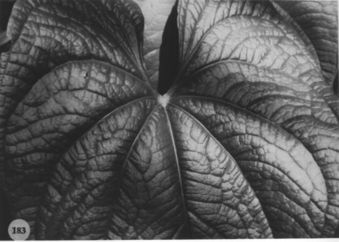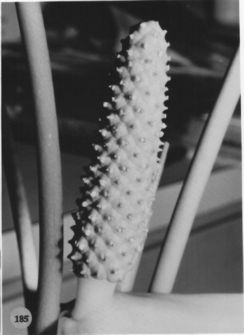






Anthurium silvigaudens Standl. & Steyerm.,
Publ. Field Mus. Nat. Hist., Bot. Ser. 22: 69. 1940. TYPE: Guatemala. Alta Verapaz nearTaclic.elev.ca. 1,500m, Standley 70505 (F, holotype).
Epiphytic or usually terrestrial to 120 cm tall;stems green, 2 cm diam.; internodes 1-2 cm long; leaf scars 1.4 cm wide; roots medium thick, pale green, directed downward; cataphylls subcoria-ceous, 6-13 cm long, the apex round with a minute apiculum, drying tan (B & K Yellow-red 9/ 10), weathering to linear fibers and persisting.
LEAVES usually erect; petioles 23-54 cm long, 5-6 mm diam., terete; geniculum 1.5-2 cm long; blades ovate, moderately thin, gradually acuminate at apex, lohed al base, 22-48 cm long, 13-31 cm wide, broadest just below middle; anterior lobe 17-33 cm long, the margins convex: posterior lobes 8.2-15 cm long, directed upward; the sinus hippocrepiform to spathulate, round to acute at apex; both surfaces matte (cells on lower surface glistening and weakly papillate); the midrib sharply raised above, diminishing at center, sunken at apex, bluntly raised below; basal veins 4-7 pairs, the first and second (sometimes third) free to base, the third to seventh coalesced 1-3.5 cm; posterior ribs naked, upturned; primary lateral veins 4-6 per side, departing midrib at 45°-55° angle, sunken in valleys above, raised below, straight or arching to collective vein; lesser veins prominulous above and below; collective vein arising from first or second basal vein, 4-10 mm from margin.
INFLORESCENCE erect, much shorter than leaves; peduncle 3.5-10
cm long, 6-7 mm diam., terete, shorter than petioles; spathe subcoriaceous,
medium green (B & K Yellow-green 7/10), ovate, 5.5-8.5 cm long, 4.3-6
cm wide, broadest just above point of attachment, abruptly acuminate at
apex, cordate at base, inserted at 40° angle on peduncle; the stipe
7-15 mm long in front, 4 mm long in back, tapered at base ofspadix, medium
green; spadix medium green (B & K Yellow-green 7/2.5), 2.5-5.2 cm long,
1.4-2 cm diam. at base, 5-8 mm diam. at apex; flowers rhombic to sub-4-lobed,
3.5-4 mm long, 3.6-4 mm wide, the sides sigmoid to jag-gedly sigmoid, sometimes
broadly rounded parallel to the spirals; 5 flowers visible in the principal
spiral, 7 flowers visible in the alternate spiral;
lepals matte to semiglossy, lateral tepals 2.2-2.5 mm wide, the inner
margin broadly rounded and turned up against the pistil; the pistil emergent
to ca. 0.7 mm, darker green than tepals; stigma 0.3 mm long, round, brushlike,
glistening; stamens emerging promptly throughout the spadix (sometimes
beginning at apex), the lateral stamens emerging throughout before the
alternates emerge, the third and fourth stamens following in rapid sequence
after 1 or 2 days; filaments exserted. 0.5 mm long, translucent; anthers
pale yellow, retracted to upper edge of tepals, 0.7-0.8 mm long, 1 mm wide;
thecae oblong-ellipsoid, slightly divaricate; pollen creamy white.
INFRUCTESCENCE erect; spathe persistent: spadix 4-6 cm long, 2.5-4 cm diam.; berries obovoid, vermillion-coral (see Steyermark 51703), rounded at apex, 11-13 mm long, 6-8 mm diam.;seeds 2, oblong-obovoid, weakly flattened, 5.5-7.5 mm long, 3.5-4 mm wide, 2-2.5 mm thick. Figs. 182, 183, and 185.
Anthurium silvigaudens is found in Guatemala and Honduras at
1,500 to 2,000 m elevation in tropical wet forest. In Guatemala it has
been collected in the Department of Alta Verapaz in the vicinity of Purulha
and Tactic as well as in the Department of Huchuctenango in the Sierra
de los Cuchumantes. It is certainly expected to be found in the Department
of Quiche as well. In Honduras it was collected near Lepaera.
The species is characterized by its moderately thin, ovate, prominently
lobed leaf blades with weakly impressed secondary and tertiary veins, by
its short peduncle, its ovate, cordate, green spathe, stubby greenish spadix,
and orange-red berries. Its sectional placement is uncertain but may best
be placed in section Belolonchium.
Although Standley and Sleyermark in the type description compare the
species with A. fraternum Schott it bears little resemblance or
relationship with that species except for having a blade of similar shape.
It is unlikely that the species is even in section Calomystrium.
It is apparently not closely related to any other species in Central America.
 |
 |
 |
Map of Mesoamerican specimens with coordinates
Guatemala Alta Verapaz: 1200 m,, 18 July 1977, Thomas B. Croat
41475 (MO).
Guatemala Baja Verapaz: 1620-1720 m, 15.13N 90.12W, 26 Jan. 1987, Thomas
B. Croat & Dylan P. Hannon 63738 (MO).
Guatemala Baja Verapaz: 1660 m.,, 15 Jun. 1985, Martínez & Tellez
13065 (MEXU).
Guatemala Baja Verapaz: 1630 m,, 22 July 1988, Martínez S., E.M. et
al. 23079 (MEXU).
Honduras Yoro: Cordillera Nombre de Dios, 250 m, 15.31N 87.26W,
13 May 1991, Gerrit Davidse, Ramón Zúniga & Paul R. House
34367 (MO).